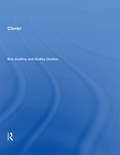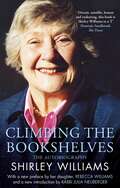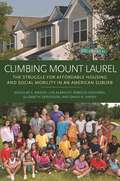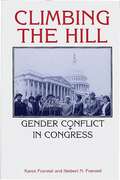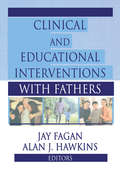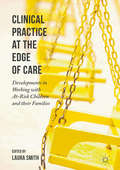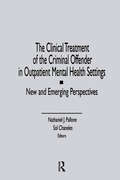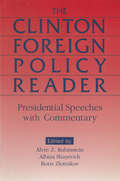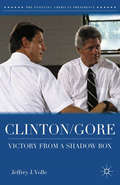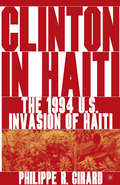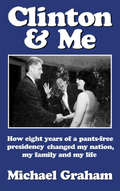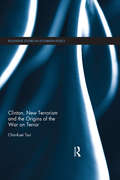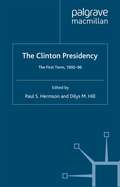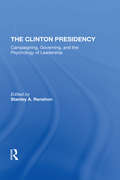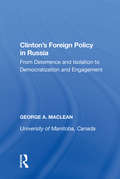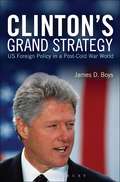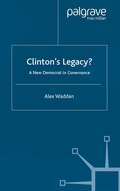- Table View
- List View
Climb/h
by Bob Godfrey Dudley CheltonThis book is a collection of rock climbing experiences which captures the essence, the challenge, and the spirit of the sport at its best. It describes the historical interplay between events and personalities in Colorado rock climbing, and shows how the concept of the impossible was redefined.
Climb/h
by Bob Godfrey Dudley CheltonThis book is a collection of rock climbing experiences which captures the essence, the challenge, and the spirit of the sport at its best. It describes the historical interplay between events and personalities in Colorado rock climbing, and shows how the concept of the impossible was redefined.
Climbing The Bookshelves: The autobiography of Shirley Williams
by Shirley WilliamsThe role of women in our society has changed out of all recognition. But it has changed least in the House of Commons. I want to describe those changes and the resistances to them through the magnifying glass of my own life, a life that coincides with our turbulent post-war history.'Shirley Williams was born to politics. As well as being influenced by her mother, Vera Brittian, her father George Caitlin, a leading political scientist, encouraged his daughter to have high ambitions for herself - including daring to climb the bookshelves in his library. Elected as MP for Hitchin in 1964, she was a member of the Wilson and Callaghan governments and was also the Secretary of State for Education. As one of the 'Gang of Four' Shirley Williams famously broke away from the Labour Party to found the SDP in 1981 and later supported its merger with the Liberal Party to form the Liberal Democrats. CLIMBING THE BOOKSHELVES is the voice of strong and passionate woman of luminous intelligence.
Climbing Mount Laurel: The Struggle for Affordable Housing and Social Mobility in an American Suburb
by Douglas S. Massey Len Albright Rebecca Casciano Elizabeth Derickson David N. KinseyUnder the New Jersey State Constitution as interpreted by the State Supreme Court in 1975 and 1983, municipalities are required to use their zoning authority to create realistic opportunities for a fair share of affordable housing for low- and moderate-income households. Mount Laurel was the town at the center of the court decisions. As a result, Mount Laurel has become synonymous with the debate over affordable housing policy designed to create economically integrated communities. What was the impact of the Mount Laurel decision on those most affected by it? What does the case tell us about economic inequality?Climbing Mount Laurel undertakes a systematic evaluation of the Ethel Lawrence Homes--a housing development produced as a result of the Mount Laurel decision. Douglas Massey and his colleagues assess the consequences for the surrounding neighborhoods and their inhabitants, the township of Mount Laurel, and the residents of the Ethel Lawrence Homes. Their analysis reveals what social scientists call neighborhood effects--the notion that neighborhoods can shape the life trajectories of their inhabitants. Climbing Mount Laurel proves that the building of affordable housing projects is an efficacious, cost-effective approach to integration and improving the lives of the poor, with reasonable cost and no drawbacks for the community at large.
Climbing Mount Laurel: The Struggle for Affordable Housing and Social Mobility in an American Suburb (PDF)
by Douglas S. Massey Len Albright Rebecca Casciano Elizabeth Derickson David N. KinseyUnder the New Jersey State Constitution as interpreted by the State Supreme Court in 1975 and 1983, municipalities are required to use their zoning authority to create realistic opportunities for a fair share of affordable housing for low- and moderate-income households. Mount Laurel was the town at the center of the court decisions. As a result, Mount Laurel has become synonymous with the debate over affordable housing policy designed to create economically integrated communities. What was the impact of the Mount Laurel decision on those most affected by it? What does the case tell us about economic inequality?Climbing Mount Laurel undertakes a systematic evaluation of the Ethel Lawrence Homes--a housing development produced as a result of the Mount Laurel decision. Douglas Massey and his colleagues assess the consequences for the surrounding neighborhoods and their inhabitants, the township of Mount Laurel, and the residents of the Ethel Lawrence Homes. Their analysis reveals what social scientists call neighborhood effects--the notion that neighborhoods can shape the life trajectories of their inhabitants. Climbing Mount Laurel proves that the building of affordable housing projects is an efficacious, cost-effective approach to integration and improving the lives of the poor, with reasonable cost and no drawbacks for the community at large.
Climbing the Hill: Gender Conflict in Congress (Non-ser.)
by Herbert N. Foerstel Karen P. FoerstelClimbing the Hill explores the history and current status of women members and staff on Capitol Hill. It traces the difficult history of women in Congress, their slow and painful path to political power and their hopes and fears of today. It presents a comprehensive analysis of women's success at the polls and within the congressional hierarchy—legislatively, politically, and socially. Through in-depth research and extensive personal interviews, the authors reveal the deep-rooted sexual divisions within the U.S. Congress and the continuing struggle of women to break into the old boy network. The book's comprehensive coverage is unique and up-to-date and will be of interest to scholars, students, and interested layreaders.
Clinical and Educational Interventions with Fathers
by Jay Fagan Alan HawkinsCall on men's hidden strengths to help them become responsible fathers in even the most challenging circumstances!Clinical and Educational Interventions with Fathers gives you fresh approaches for effective interventions with fathers. Whether by calling on their faith to help them deal with the complexities of fatherhood or offering high-tech interventions on the Internet, these techniques help men find their strengths, maintain their masculinity, and learn to guide, nurture, and discipline with love and responsibility. Instead of thinking of fathers as deficient, the book emphasizes finding fathers’strengths and potentials for growth. It also respects the diversity of parenting styles among fathers from various ethnic, racial, and class backgrounds.No man wants to be a bad father. Nevertheless, many men in our culture do not know how to care for the children they beget. Trapped by stereotypes of masculine behavior and deprived of positive role models, they find themselves trying to do the challenging work of fatherhood without the necessary resources, information, or support.Clinical and Educational Interventions with Fathers offers positive approaches to helping men become responsible fathers, including: designing special techniques and programs to help fathers in prison and other challenging circumstances helping fathers manage anger developing therapeutic support groups for African-American men offering Web-based support for fathers training staff to recognize and respond to fathers’unique needs finding legal tools to support fathers’rightsReaching fathers has become an ever more urgent priority for practitioners as family structure and family life change. Traditional social-service programs for mothers tend not to work well with men's very different needs and attitudes. Yet very little has been published on successful interventions with fathers. Clinical and Educational Interventions with Fathers fills that gap and suggests promising new directions for further research in this field. By offering positive, tested ways to help men become responsible fathers, this volume will help you improve their lives and the lives of their sons and daughters.
Clinical and Educational Interventions with Fathers
by Jay Fagan Alan HawkinsCall on men's hidden strengths to help them become responsible fathers in even the most challenging circumstances!Clinical and Educational Interventions with Fathers gives you fresh approaches for effective interventions with fathers. Whether by calling on their faith to help them deal with the complexities of fatherhood or offering high-tech interventions on the Internet, these techniques help men find their strengths, maintain their masculinity, and learn to guide, nurture, and discipline with love and responsibility. Instead of thinking of fathers as deficient, the book emphasizes finding fathers’strengths and potentials for growth. It also respects the diversity of parenting styles among fathers from various ethnic, racial, and class backgrounds.No man wants to be a bad father. Nevertheless, many men in our culture do not know how to care for the children they beget. Trapped by stereotypes of masculine behavior and deprived of positive role models, they find themselves trying to do the challenging work of fatherhood without the necessary resources, information, or support.Clinical and Educational Interventions with Fathers offers positive approaches to helping men become responsible fathers, including: designing special techniques and programs to help fathers in prison and other challenging circumstances helping fathers manage anger developing therapeutic support groups for African-American men offering Web-based support for fathers training staff to recognize and respond to fathers’unique needs finding legal tools to support fathers’rightsReaching fathers has become an ever more urgent priority for practitioners as family structure and family life change. Traditional social-service programs for mothers tend not to work well with men's very different needs and attitudes. Yet very little has been published on successful interventions with fathers. Clinical and Educational Interventions with Fathers fills that gap and suggests promising new directions for further research in this field. By offering positive, tested ways to help men become responsible fathers, this volume will help you improve their lives and the lives of their sons and daughters.
Clinical Practice at the Edge of Care: Developments in Working with At-Risk Children and their Families
by Laura SmithThis book brings together psychological and psychotherapeutic contributions in clinical practice with at-risk children and their families. Chapters by experts working in a range of edge-of-care settings give an essential account of real-world clinical challenges and dilemmas; whilst drawing on relevant theory and the growing evidence base for edge of care work with children and families. This title will be of interest to both clinical and social work practitioners, those commissioning and developing best practice in edge of care services, scholars and students of Clinical Psychology, Systemic Psychotherapy and related disciplines.
The Clinical Treatment of the Criminal Offender in Outpatient Mental Health Settings: New and Emerging Perspectives
by Letitia C PalloneThis volume brings together in a single source a set of perspectives by leaders in the clinical treatment of criminal offenders in outpatient settings, particularly those whose crimes have involved domestic violence and/or substance abuse. More than a set of “how to” techniques, it addresses the question of which offenders can successfully be treated in what settings by which techniques. It is a valuable resource not only for those concerned with prisons, probation, and parole, but also for those responsible for the delivery of mental health services in the community.
The Clinical Treatment of the Criminal Offender in Outpatient Mental Health Settings: New and Emerging Perspectives
by Letitia C PalloneThis volume brings together in a single source a set of perspectives by leaders in the clinical treatment of criminal offenders in outpatient settings, particularly those whose crimes have involved domestic violence and/or substance abuse. More than a set of “how to” techniques, it addresses the question of which offenders can successfully be treated in what settings by which techniques. It is a valuable resource not only for those concerned with prisons, probation, and parole, but also for those responsible for the delivery of mental health services in the community.
Clinton Foreign Policy Reader: Presidential Speeches with Commentary
by Alvin Z. RubinsteinAn introduction to the main issues of American foreign policy as it has evolved during the first post-Cold War presidency. There are substantive excerpts from major presidential policy statements to illustrate the points and turning points discussed in each chapter. The collection is intended as a supplementary text in American foreign policy and contemporary international relations. It includes a bibliography and a guide to accessing contemporary foreign policy information on line.
Clinton Foreign Policy Reader: Presidential Speeches with Commentary
by Alvin Z. RubinsteinAn introduction to the main issues of American foreign policy as it has evolved during the first post-Cold War presidency. There are substantive excerpts from major presidential policy statements to illustrate the points and turning points discussed in each chapter. The collection is intended as a supplementary text in American foreign policy and contemporary international relations. It includes a bibliography and a guide to accessing contemporary foreign policy information on line.
Clinton/Gore: Victory from a Shadow Box (The Evolving American Presidency)
by Jeffrey J. VolleWhat if Clinton/Gore lost in 1992? Or won in 1992 and lost in 1996? This book is a look back at the importance of all the right moves made by Bill Clinton from the New Hampshire primary to the selection of Al Gore as his running mate to his handling of the Republican takeover of the House of Representatives in 1994-95.
Clinton in Haiti: The 1994 US Invasion of Haiti
by P. GirardThe book focuses on Aristide's political career, emphasizing his strategizing, compromising and dealing with the Clinton administration. In his presentation of the conflict, Girard carefully balances Aristide's and Clinton's needs, and the demands and moral positions the leaders make against each other - the result is that each leader and his constituency comes to life, and their maneuverings and decisions become engaging and meaningful. While Girard focuses on the conflict itself and the foreign policy dynamics at play between Haiti and the US, he also paints a compelling picture of contemporary Haiti and delineates with great clarity the tensions which led to recent violence and the deposition of Aristide.
Clinton & Me: How Eight Years Of A Pants-free Presidency Changed My Nation, My Family And My Life
by Michael GrahamThe same week William Jefferson Clinton was sworn in as head of our national family, I became a father.And so begins one columnist's journey through the Clinton presidency. For humorist and political commentator Michael Graham, the trip is a hilarious tour de farce of America at its most ridiculous, and its most real. In the tradition of H. L. Menken (after whom his son is named) and P. J. O'Rourke, Michael Graham lets fly his lampoons on deserving targets across the American landscape. From Al Gore on the left ("the ideology of Ralph Nader, the ethics of Richard Nixon") to Strom Thurmond on the right (campaign slogan: "Getting Out of Bed for More Than 94% of a Century!"), Graham casts his merrily cynical eye and sees all. Graham begins this collection of contemporary humor with an overview of the Clinton years and how they have changed him as a citizen, a father, and a writer ("What other president could turn the phrase 'face time' into an instant punchline?") He proceeds to take us on a joyous ride through the peaks and valleys of the pants-free presidency.It's all here: Filegate, Travelgate, the Buddhist Temple and, of c
Clinton, New Terrorism and the Origins of the War on Terror (Routledge Studies in US Foreign Policy)
by Chin-Kuei TsuiA frequent assumption of the American-led ‘war on terror’ and its accompanying discourse originated largely with the George W. Bush Administration, and that there was a counterterrorism policy revolution in the U.S. political arena. Challenging these assumptions, through a genealogical analysis of U.S. terrorism and counterterrorism discourses, this book demonstrates a distinct continuity (and lack of change) of U.S. counterterrorism policy, from Ronald Reagan, to Bill Clinton, and through to George W. Bush. The book focuses on President Clinton’s discursive construction of ‘new terrorism’, or ‘catastrophic terrorism’, and the counterterrorism practices implemented by the Clinton Administration, while simultaneously comparing it with President Reagan’s and President George W. Bush’s approaches to counterterrorism. It shows how the war on terror can be traced to earlier periods, and that the so-called Bush revolution was largely built upon the existing framework established by President Reagan and President Clinton. Prior to the 2001 terrorist attacks, Clinton had expanded Reagan’s first ‘war on terrorism’ discourse and constructed the ‘new terrorism’ discourse, characterised by the notions of borderless threats, ‘home-grown’ terrorism, WMD-terrorism, cyberterrorism, and rogue states. Clinton’s ‘new terrorism’ discourse provided a useful framework for George W. Bush to discursively respond to the terrorist attacks on September 11th, 2001. Aiming to uncover the myth of President George W. Bush’s foreign policy revolution and contribute to a deeper historical understanding of the U.S.-led war on terror, it will be of great use to postgraduates and scholars of US foreign policy, security studies and terrorism studies.
Clinton, New Terrorism and the Origins of the War on Terror (Routledge Studies in US Foreign Policy)
by Chin-Kuei TsuiA frequent assumption of the American-led ‘war on terror’ and its accompanying discourse originated largely with the George W. Bush Administration, and that there was a counterterrorism policy revolution in the U.S. political arena. Challenging these assumptions, through a genealogical analysis of U.S. terrorism and counterterrorism discourses, this book demonstrates a distinct continuity (and lack of change) of U.S. counterterrorism policy, from Ronald Reagan, to Bill Clinton, and through to George W. Bush. The book focuses on President Clinton’s discursive construction of ‘new terrorism’, or ‘catastrophic terrorism’, and the counterterrorism practices implemented by the Clinton Administration, while simultaneously comparing it with President Reagan’s and President George W. Bush’s approaches to counterterrorism. It shows how the war on terror can be traced to earlier periods, and that the so-called Bush revolution was largely built upon the existing framework established by President Reagan and President Clinton. Prior to the 2001 terrorist attacks, Clinton had expanded Reagan’s first ‘war on terrorism’ discourse and constructed the ‘new terrorism’ discourse, characterised by the notions of borderless threats, ‘home-grown’ terrorism, WMD-terrorism, cyberterrorism, and rogue states. Clinton’s ‘new terrorism’ discourse provided a useful framework for George W. Bush to discursively respond to the terrorist attacks on September 11th, 2001. Aiming to uncover the myth of President George W. Bush’s foreign policy revolution and contribute to a deeper historical understanding of the U.S.-led war on terror, it will be of great use to postgraduates and scholars of US foreign policy, security studies and terrorism studies.
The Clinton Presidency: The First Term, 1992-96 (Southampton Studies in International Policy)
by Dilys M. Hill Paul S. HerrnsonThe first Democratic president for twelve years, William Jefferson Clinton entered the White House on a note of optimism, pledged to give priority to economic policy and his domestic agenda of healthcare and welfare reforms. President Clinton - the 'Man from Hope' - faced what looked like a fresh opportunity to move ahead with legislation. The years of 'gridlock', whereby a president of one political party faced a Congress dominated by another, were over. This volume analyses in depth the processes and policies of the Clinton presidency. It reveals the contradictions, achievements, reversals and triumphs of a complex and fascinating president and his administration.
The Clinton Presidency: Campaigning, Governing, And The Psychology Of Leadership
by Stanley RenshonThe Clinton presidency faced a basic set of public questions at the outset regarding its real intentions, strategies, and competence. Would the administration be able to develop and implement policies that were constructive in intent, fair in formulation, and successful in result? Would President Clinton be able to govern as successfully as he campaigned? Would there be a productive fit between Clinton's leadership style and the needs of the public? Additional questions arise about Clinton personally. Many admire him; others distrust him. What realistic basis is there for either view? This book explores these questions and develops an initial appraisal of the Clinton presidency. The chapters herein are framed by theories of political leadership and psychology. They draw on a diverse body of theories, including psychological theories of character and personality, cognitive psychology and communication theory, theories of presidential leadership and performance, and theories of public psychology. The goal is to examine the many facets of leadership and governing that constitute the modern presidency and to locate Bill Clinton's emerging presidency within that framework. Bill Clinton is and likely will remain a controversial president. One objective of this analysis is to provide a clearer, more objective framework in which to evaluate both the man and his approach to political leadership and executive power and the consequences of his approach for public psychology and policy.
The Clinton Presidency: Campaigning, Governing, And The Psychology Of Leadership
by Stanley RenshonThe Clinton presidency faced a basic set of public questions at the outset regarding its real intentions, strategies, and competence. Would the administration be able to develop and implement policies that were constructive in intent, fair in formulation, and successful in result? Would President Clinton be able to govern as successfully as he campaigned? Would there be a productive fit between Clinton's leadership style and the needs of the public? Additional questions arise about Clinton personally. Many admire him; others distrust him. What realistic basis is there for either view? This book explores these questions and develops an initial appraisal of the Clinton presidency. The chapters herein are framed by theories of political leadership and psychology. They draw on a diverse body of theories, including psychological theories of character and personality, cognitive psychology and communication theory, theories of presidential leadership and performance, and theories of public psychology. The goal is to examine the many facets of leadership and governing that constitute the modern presidency and to locate Bill Clinton's emerging presidency within that framework. Bill Clinton is and likely will remain a controversial president. One objective of this analysis is to provide a clearer, more objective framework in which to evaluate both the man and his approach to political leadership and executive power and the consequences of his approach for public psychology and policy.
Clinton's Foreign Policy in Russia: From Deterrence and Isolation to Democratization and Engagement
by George A. MacLeanSome of Bill Clinton's most basic foreign policy elements - democratic peace, the post-Cold War peace dividend, geopolitics and state-society relations - are epitomized in the US-Russian Highly Enriched Uranium (HEU) Purchase Agreement. It was one of the most remarkable initiatives of Clinton's presidency, but oddly one of the most obscure that still continues under George W. Bush. This agreement illustrates how successfully the US and Russia could work together to reduce global nuclear fears but also how a series of decisions pitted global designs over American domestic interests. Illustrating one of the most compelling decisions Clinton made as President, this remarkable book elucidates the theory of democratic peace and demonstrates a new and more advanced nuclear restraint regime, from reduction to elimination. The story behind Clinton's decision has repercussions for our understanding of arms control, foreign policy decision making and US-Russian relations. This is a book about the intersection of levels of analysis, international security concerns and domestic political economy, and as such is ideal as a supplementary text for advanced courses in security and foreign policy.
Clinton's Foreign Policy in Russia: From Deterrence and Isolation to Democratization and Engagement
by George A. MacLeanSome of Bill Clinton's most basic foreign policy elements - democratic peace, the post-Cold War peace dividend, geopolitics and state-society relations - are epitomized in the US-Russian Highly Enriched Uranium (HEU) Purchase Agreement. It was one of the most remarkable initiatives of Clinton's presidency, but oddly one of the most obscure that still continues under George W. Bush. This agreement illustrates how successfully the US and Russia could work together to reduce global nuclear fears but also how a series of decisions pitted global designs over American domestic interests. Illustrating one of the most compelling decisions Clinton made as President, this remarkable book elucidates the theory of democratic peace and demonstrates a new and more advanced nuclear restraint regime, from reduction to elimination. The story behind Clinton's decision has repercussions for our understanding of arms control, foreign policy decision making and US-Russian relations. This is a book about the intersection of levels of analysis, international security concerns and domestic political economy, and as such is ideal as a supplementary text for advanced courses in security and foreign policy.
Clinton's Grand Strategy: US Foreign Policy in a Post-Cold War World (Criminal Practice Ser.)
by James D. BoysPresident Clinton's time in office coincided with historic global events following the end of the Cold War. The collapse of Communism called for a new US Grand Strategy to address the emerging geopolitical era that brought upheavals in Somalia and the Balkans, economic challenges in Mexico and Europe and the emergence of new entities such as the EU, NAFTA and the WTO. Clinton's handling of these events was crucial to the development of world politics at the dawn of the twenty-first century. Only by understanding Clinton's efforts to address the challenges of the post-Cold War era can we understand the strategies of his immediate successors, George W. Bush and Barack Obama, both of whom inherited and continued Clinton-era policies and practices. James D. Boys sheds new light on the evolution and execution of US Grand Strategy from 1993 to 2001. He explores the manner in which policy was devised and examines the actors responsible for its development, including Bill Clinton, Anthony Lake, Samuel Berger, Warren Christopher, Madeline Albright and Richard Holbrook. He examines the core components of the strategy (National Security, Prosperity Promotion and Democracy Promotion) and how they were implemented, revealing a hitherto unexplored continuity from campaign trail to the White House. Covering the entire duration of Clinton's presidential odyssey, from his 1991 Announcement Speech to his final day in office, the book draws extensively on newly declassified primary materials and interviews by the author with key members of the Clinton administration to reveal for the first time the development and implementation of US Grand Strategy from deep within the West Wing of the Clinton White House.
Clinton's Legacy: A New Democrat In Governance
by A. WaddanAs Clinton left office there was little consensus even among Democrats as to the significance of his political legacy. He was keen to stress that enduring changes had been made to American society. Critics, however, were less convinced that Clintonism had developed an integrated vision of governance. This book examines whether the Clinton experience does illustrate the value of the New Democrat and Third Way agenda.
